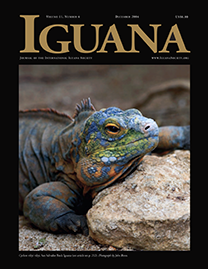Conservation of Iguanas (Iguana delicatissima and I. iguana) in the Lesser Antilles
Keywords:
Lesser Antillean Iguanas, Iguana delicatissima, Green Iguanas, Iguana iguana, Lesser Antilles, Conservation, Habitat Degradation, Mammalian Predators and Competitors, HybridizationAbstract
Lesser Antillean iguana populations include at least two species, Iguana delicatissima and I. iguana, the latter of which may actually represent several species-level taxa. Iguana delicatissima is endemic to the region, as are at least two unique populations of I. iguana. Other populations in the region may have arrived naturally from South American by means of over-water dispersal, been introduced by Amerindians within the past 7,000 years, or been introduced within the past several decades as a by-product of the international pet trade. Although most extant populations of I. delicatissima are critically endangered, declines have been documented for several, and the gene pools of others have been contaminated as a consequence of hybridization with introduced populations of I. iguana, the species is considered only “vulnerable” according to IUCN Red List criteria. Iguana iguana is not listed. Protection is afforded both species under the auspices of CITES Appendix II, which lists all iguanids, but which includes provision for the harvest and export of I. iguana from many nations without consideration of the genetic distinctiveness of any population.
Most island populations are small, which renders them vulnerable to natural or human-mediated, stochastic or non-random events. In addition to hybridization, development-related habitat destruction and alteration, introduction of alien plants, predators, and competitors, and ongoing hunting pressure contribute to the precarious state of most populations. Conservation plans must be implemented and will have to include provisions for surveys and field research, establishment of protected areas within which livestock must be controlled, predator control strategies in some instances, extensive educational efforts, and, in at least the instance of the St. Lucian Iguana, a captive-breeding and headstarting program.

